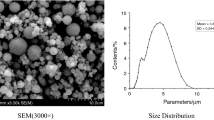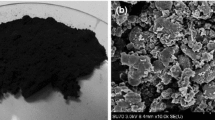Abstract
Aluminum(Al)/ammonium perchlorate(AP)/hydroxyl-terminated polybutadiene (HTPB) propellant is the most widely used propulsion system currently. Its ignition and combustion processes are fairly complex and need to be better understood. In this study, the thermal decomposition, ignition, and combustion properties of an Al/AP/HTPB propellant were investigated using a thermogravimetry–differential scanning calorimetry and a laser ignition testing system. The morphology and size distribution of the condensed combustion products (CCPs) were analyzed using a laser particle size analyzer and scanning electron microscopy. Results showed that the thermal decomposition process of the propellant consisted of three stages. The first stage (100–430 °C) was a major mass loss stage and exhibited typical features of AP decomposition. The second stage (430–630 °C) was mainly accompanied by the decomposition of remaining HTPB as well as slight oxidation of Al particles. In the third stage, further oxidation of Al particles resulted in a small mass increase. Due to the continuous emission problem, only a few combustion intermediates were identified in the combustion emission spectrum curves. The propellant combustion process could be roughly divided into three stages, and the flame development stage lasted longer than the flame decline stage. As the pressure increased, the propellant ignition delay time decreased and the burning rate increased significantly. The effect of pressure on ignition delay was more pronounced at low pressures. The CCPs consisted of three types. The oxidation of Al particles in the propellant followed the diffusion reaction mechanism. Agglomerates appeared in several different morphologies and had relatively low combustion efficiency under experimental conditions. A 2-D pocket-like structure was observed on the propellant surface.











Similar content being viewed by others
References
Mallick L, Kumar S, Chowdhury A. Thermal decomposition of ammonium perchlorate—a TGA-FTIR-MS study: part I. Thermochim Acta. 2017;653:83–96.
Wang Y, Liu L, Xiao L, Wang Z. Thermal decomposition of HTPB/AP and HTPB/HMX mixtures with low content of oxidizer. J Therm Anal Calorim. 2015;119:1673–8.
Padwal MB, Varma M. Thermal decomposition and combustion characteristics of HTPB-coarse AP composite solid propellants catalyzed with Fe2O3. Combust Sci Technol. 2018;190:1614–29.
Yuan J, Liu J, Zhou Y, Wang J, Xv T. Aluminum agglomeration of AP/HTPB composite propellant. Acta Astronaut. 2019;156:14–22.
Trache D, Maggi F, Palmucci I, DeLuca LT. Thermal behavior and decomposition kinetics of composite solid propellants in the presence of amide burning rate suppressants. J Therm Anal Calorim. 2018;132:1601–15.
Trunov MA, Schoenitz M, Zhu X, Dreizin EL. Effect of polymorphic phase transformations in Al2O3 film on oxidation kinetics of aluminum powders. Combust Flame. 2005;140:310–8.
Zhou Y, Liu J, Wang J, Xv T, Liang D, Cen K. The formation mechanism and distribution of micro-aluminum oxide layer. J Therm Anal Calorim. 2018;133:1335–44.
Liau Y-C, Kim ES, Yang V. A comprehensive analysis of laser-induced ignition of RDX monopropellant. Combust Flame. 2001;126:1680–98.
Herreros DN, Fang X. Laser ignition of elastomer-modified cast double-base (EMCDB) propellant using a diode laser. Opt Laser Technol. 2017;89:21–6.
Zenin AA, Zanotti C, Jiuliani P. Characteristics of composite propellant ignition by a CO2-laser. Russ J Phys Chem B. 2014;8:475–84.
Wang HM, Chen X, Zhao C. NEPE propellant ignition and combustion under laser irradiation. Adv Mater Res. 2014;1042:10–4.
Liu L, Li J, Zhang L, Tian S. Effects of magnesium-based hydrogen storage materials on the thermal decomposition, burning rate, and explosive heat of ammonium perchlorate-based composite solid propellant. J Hazard Mater. 2018;342:477–81.
Yousef MA, Hudson MK. Thermal study of the decomposition of HTPB hybrid rocket fuel in the presence of azo-tetrazolate-based high nitrogen content high energy materials. J Therm Anal Calorim. 2018;134:1785–97.
Zhou Y, Liu J, Liang D, Zhou J, Yang W, Shi W. Effect of particle size and oxygen content on ignition and combustion of aluminum particles. Chin J Aeronaut. 2017;30:1835–43.
Edwards T, Weaver DP, Campbell DH, Hulsizer S. Investigation of high pressure solid propellant combustion chemistry using emission spectroscopy. J Propuls Power. 1986;2:228–34.
Liang D, Liu J, Xiao J, Xi J, Wang Y, Zhang Y, et al. Energy release properties of amorphous boron and boron-based propellant primary combustion products. Acta Astronaut. 2015;112:182–91.
Roth E, Weiser V, Knapp S, Raab A, Kelzenberg S. Emission spectroscopy of the combustion flame of aluminium/copper oxide thermite. Propellants Explos Pyrotech. 2018;44:9–17.
Yagodnikov DA, Andreev EA, Vorob’Ev VS, Glotov OG. Ignition, combustion, and agglomeration of encapsulated aluminum particles in a composite solid propellant. I. Theoretical study of the ignition and combustion of aluminum with fluorine-containing coatings. Combust Explos Shock Waves. 2006;42:534–42.
Ao W, Liu P, Yang W. Agglomerates, smoke oxide particles, and carbon inclusions in condensed combustion products of an aluminized GAP-based propellant. Acta Astronaut. 2016;129:147–53.
Beckstead MW. An overview of aluminum agglomeration modeling. In: 50th Annu Isr Aerosp Sci Conf. 2009. p 1–28.
Zhou Y, Liu J, Wang J, Xv T, Wang J, Zhou J, et al. Experimental study on dynamic combustion characteristics of aluminum particles. Propellants Explos Pyrotech. 2017;42:982–92.
King MK. Aluminum combustion in a solid rocket motor environment. Proc Combust Inst. 2009;32:2107–14.
Author information
Authors and Affiliations
Corresponding author
Additional information
Publisher's Note
Springer Nature remains neutral with regard to jurisdictional claims in published maps and institutional affiliations.
Rights and permissions
About this article
Cite this article
Yuan, J., Liu, J., Zhou, Y. et al. Thermal decomposition and combustion characteristics of Al/AP/HTPB propellant. J Therm Anal Calorim 143, 3935–3944 (2021). https://doi.org/10.1007/s10973-020-09297-4
Received:
Accepted:
Published:
Issue Date:
DOI: https://doi.org/10.1007/s10973-020-09297-4




